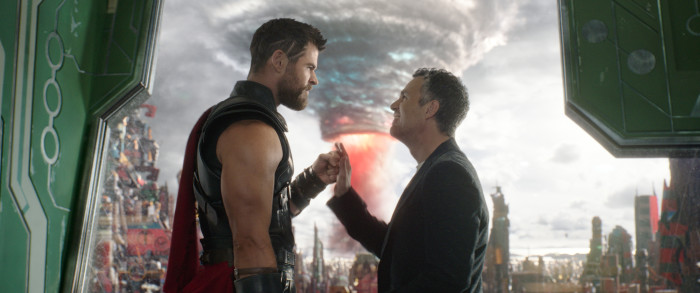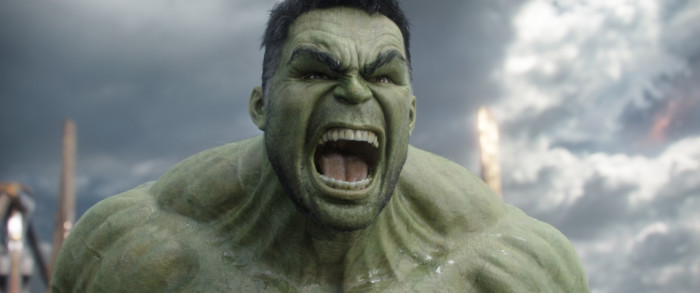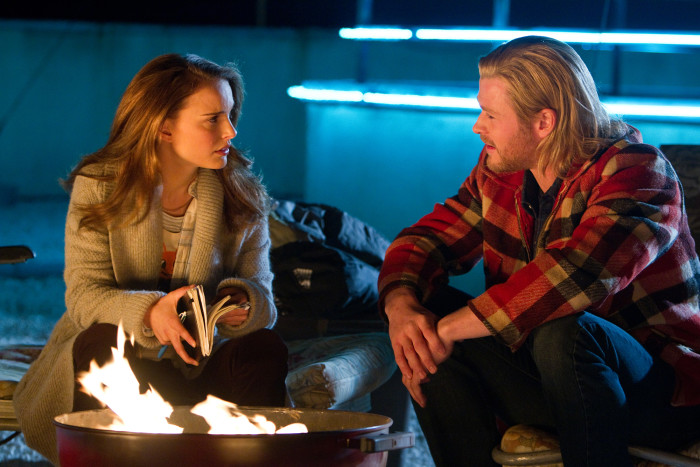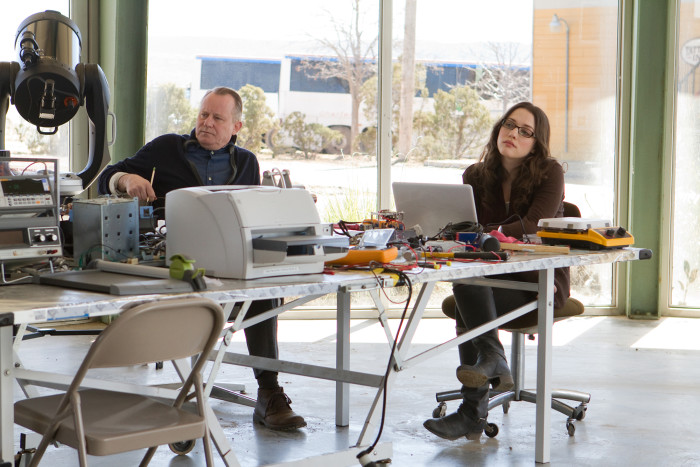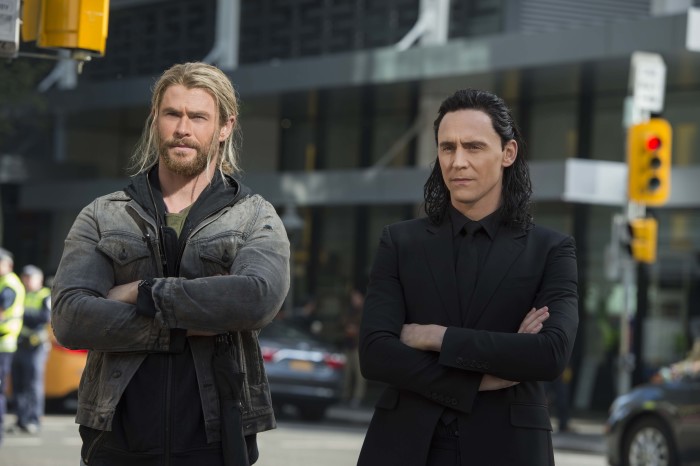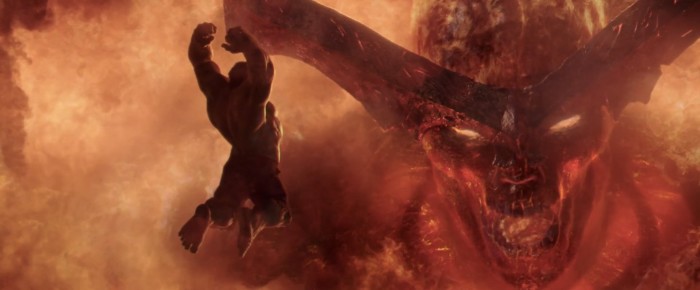How 'Thor: Ragnarok' Changes The Character's Movie And Comics History
Thor: Ragnarok has been a rousing success for Marvel Studios. Commercially, the film cleaned up at the box office on its opening weekend. Critically, it stands as one of the best-reviewed movie in the Marvel Cinematic Universe, with only the original Iron Man rating one percent higher on Rotten Tomatoes.
I grew up reading Thor and other Marvel Comics — I even had a fan letter printed in the back of Thor, Vol. 2 #36 (2001). And while I enjoyed the new movie immensely, I initially had a few qualms about its treatment of the Thor mythos. And not just the comic book mythos, but also the movie mythos. Director Taiki Waititi casually discards much of the God of Thunder's previous history, jettisoning old supporting characters in favor of new ones...but maybe that was a necessary step to liberate the character.
At the very least, it can be said that Thor: Ragnarok offers a fun, deeply heretical take on what came before it. Let's address some of the sweeping changes the film has made to the Thor series, and why those changes might have been made. Spoilers follow, of course.
Thor and Hulk: New Best Friends
People called Captain America: Civil War "Avengers 2.5" for how it looped in so many Avengers characters and was as much a continuation of Tony Stark's story as it was a Steve Rogers adventure. In the same way, Thor: Ragnarok offers the only continuation of Hulk's story that we are likely to get outside the Avengers franchise. Just last month, our own Hoai-Tran Bui detailed why Marvel won't make a solo Hulk movie (it has to do with rights between Marvel Studios and Universal).
Before its release, Mark Ruffalo had teased that Thor: Ragnarok would be an "intergalactic buddy road movie." The film certainly delivers on that, with Chris Hemsworth's attempted Hulk-whispering a la Black Widow in Age of Ultron ("Sun's going down, sun's going down") being an amusing callback that serves as one of the film's funniest moments.
Yet when did Thor and Hulk become such bosom buddies? In the comics, they are known more for their adversarial history, which is marked by some epic fights — my personal favorite being the one in Incredible Hulk #440, discussed by Collider here in its rundown of best Thor vs. Hulk comic fights. This adversarial tradition carries over into Thor: Ragnarok's arena fight, of course, just as it carried over into The Avengers when Thor and Hulk had their first fracas aboard the S.H.I.E.L.D. Helicarrier. Even at the end of that movie, Hulk is still more likely to send Thor flying off-screen with a deadpan punch than to warmly embrace him as a comrade-in-arms. The only time we really see Thor and Bruce Banner bonding is during the party scene in Age of Ultron, where everybody takes turns trying to lift Thor's hammer (though it is easy enough to imagine them hanging out more off-screen in Avengers Tower.)
The truth is, with no solo Hulk movie adventures on the way, pairing these two heavy-hitters off — merging them in a super-sequel, just as Civil War did with Iron Man and Captain America — simply makes the most sense, business-wise and storytelling-wise. It's a classic Marvel team-up: two for the price of one. The "Planet Hulk" storyline from Marvel Comics had already laid the precedent for the Green Goliath in outer space.
Prior to Thor: Ragnarok, the general consensus seemed to be that the first Thor was a second-tier Marvel movie, while its sequel, Thor: The Dark World, was a bottom-tier Marvel movie. In the absence of any foolproof metric, Rotten Tomatoes recently ranked the films of the MCU from worst to best by Tomatometer, and while all of them are Fresh, if not Certified Fresh, guess which one has the lowest Tomatometer rating?
Some people will tell you Thor: The Dark World is outright bad, but personally, the only Marvel movie I have actively disliked is The Incredible Hulk (the second worst Marvel movie by Tomatometer). That movie is deserving of its reputation as the red-headed stepchild of the MCU, mainly because of what a poorly rendered eyesore the Abomination is. "Third-act problems" are a common criticism of comic book movies, but when the Abomination shows up in The Incredible Hulk, the film dissolves into a sub-moronic CGI mess.
That is part of what made it such a joy to witness the Hulk stealing scenes in The Avengers, because there was a sense of the character coming home to himself on the big screen for the first time. By bringing the Hulk into the fold in Thor: Ragnarok, Marvel is also able to give the live-action treatment to one memorable element from Peter David and Gary Frank's three-part "Myth Conceptions" story arc in Incredible Hulk #421-423. In that story arc, Hulk and the Warriors Three faced off against a creature called Hoarfen, the demented progeny of a Frost Giant/Fenris Wolf coupling. Over two decades later, fans now have the chance to see Hulk face off against the Fenris Wolf itself in a larger-than-life screen tussle.
But let's bring this back to Thor. Until Thor: Ragnarok, the god of thunder never had a moment to truly shine, not to his full potential. Ragnarok remedies that. It does for Thor what The Avengers did for the Hulk. Instead of coming home, however, the character leaves home, and in fact, his home of Asgard is completely destroyed by the end of the movie. That is not to say that Asgard could not be rebuilt in the future; in writer J. Michael Straczynski's and artist Olivier Coipel's run on the Thor comic, the city of Asgard does rise again on Earth, in the state of Oklahoma.
For now, though, it is gone. Taika Waititi may have filmed the movie as an action comedy, but in a way, it still lives up to the notion of Ragnarok, the day of doom, insofar as it represents a wholesale destruction of the Thor mythos as we knew it.
Thor's Expendable Supporting Cast
Imagine a Spider-Man story where some super-villain proceeded to round up the staff of the Daily Bugle and kill off most of the recognizable faces like J. Jonah Jameson, while Aunt May and Mary Jane Watson suddenly vanished from the story altogether with no explanation for their disappearance except perhaps a throwaway line from Peter Parker joking about how he and Mary Jane had decided to dump each other.
That is how Thor: Ragnarok chooses to approach the son of Odin's previous supporting cast. Simply put: the movie is not interested in those characters anymore. It tosses aside Jane Foster and Lady Sif, played by Natalie Portman and Jamie Alexander, respectively, with little or no mention of the characters. In true Marvel movie fashion, supporting females seem to be utterly disposable. Another example of this would be Gwyneth Paltrow's Pepper Potts, who thankfully returned in Spider-Man: Homecoming, but who looked very much in danger of being written out of the MCU as another off-screen break-up when Captain America: Civil War came out.
Granted, real-life scheduling issues with actresses (or them simply not caring to return) have played a part in some of these character disappearances. But perhaps if Marvel's female characters were written as more interesting and given meatier parts to play in the story, actresses would be more inclined to find time in their busy schedules to reprise these roles.
Until recently, my significant other had never watched any of the Thor movies. In preparation for Thor: Ragnarok, she rented Thor and Thor: The Dark World and it was amazing to me to hear how invested she was in the relationship between Thor and Jane Foster after she watched those movies. I was worried this might detract from her enjoyment of Thor: Ragnarok since I knew Natalie Portman would not be returning. But after we saw the film on opening weekend, I asked her if she missed the presence of Jane Foster, and she promptly said no. She had taken an instant liking to Tessa Thompson's hard-drinking Valkyrie and Cate Blanchett's nigh-invincible Hela. In the year of Wonder Woman, with the introduction of these two new warrior women as peers to Thor, Jane Foster had been quickly forgotten.
Also gone: Dr. Erik Selvig, played by Stellan Skarsgard, and Jane's assistant, Darcy, played by Kat Dennings. Their exclusion is more understandable since most of the movie takes place off-Earth and obviously, neither of them were in a romantic relationship with Thor (that we know of). But if you missed those characters, if you wondered where they were, then you have a better memory for them than I did. It was not until I came home from the movie that I realized they were not in the movie, either. I had not thought of them once during the whole film.
Should we talk about the Warriors Three? As Ben Pearson reported on Thor: Ragnarok's opening day, this is something that Marvel Studios president and producer Kevin Feige has been pressed to comment on already. When asked to explain what happened to the Warriors Three, specifically, the manner of their untimely deaths, Feige began with a slightly stammering response of, "Well, it was a – they, they had noble ends ..."
Did they? Volstagg, Fandral, and Hogun are characters with a long comics history dating back over fifty years, and the first two Thor movies had taken great pains to show camaraderie between them and Thor. So to see two of them killed off unceremoniously the minute they show up on-screen in the Bifrost chamber in Thor: Ragnarok is somewhat jarring. That is not to say that characters should be regarded as sacred icons whose lives are untouchable for storytelling purposes, but there are ways to do death in a more meaningful context (an example would be when the first season of Netflix's Daredevil killed off a character with a similarly long comics history). Alas, of the three warriors, only Hogun, played by Tadanobu Asano (Ichi the Killer, Silence) receives anything close to a proper send-off, as he comes back from his home of Vanaheim to lead the forces of Asgard against Hela.
Besides the fact that the last movie left him mysteriously side-lined in another realm, why is it that Hogun receives such special consideration here? Well, it may have something to do with marketing. In Japan, Thor was marketed with Hogun-heavy trailers and Hogun-centric character posters. Banners in theater lobbies switched out Heimdall for Hogun, prominently displaying the Japanese actor's face next to that of star Chris Hemsworth and Oscar winners Anthony Hopkins and Natalie Portman.
To kill off such a character with zero fanfare, the way Volstagg and Fandral are killed off, would have potentially alienated some historically underrepresented Asian fans and at the very least been a slap in the face to Japanese audiences who were rooting for Asano as sort of a local celebrity. Ergo, concordantly, vis-a-vis, Hogun gets to make his last stand against Hela before she cartoonishly impales him.
But let's face it: the Warriors Three were never the best movie characters. When juxtaposed with colorful new characters like Jeff Goldblum's Grandmaster, the aforementioned Valkyrie, and Taiki Waititi's Korg (whose mellifluous Kiwi voice sounds like that of Rhys Darby from Flight of the Conchords), the Warriors Three just come off as bland and uninteresting. For Fandral the Dashing, they had already switched out the actors who played him, having Zachary Levi take over for Josh Dallas after the first movie. Be honest, did anyone really notice?
At least Levi can take solace in knowing that he will soon play the lead in his own superhero movie, Shazam!, for Marvel's "Distinguished Competition," DC. As for Volstagg the Voluminous (or Not-So-Voluminous, as the movies depicted him), well, the actor who played him, Ray Wise, already had his chance at playing the lead in another comic book movie: Punisher: War Zone.
Hey, at least Anthony Hopkins' Odin gets to go out with some grace and dignity. No thanks to Loki, ever the trickster, whose machinations have now inadvertently brought about the deaths of his own adoptive mother and father.
Speaking of Loki...
Loki Reformed, Surtur as Comic Relief
For a long time, Tom Hiddleston's Loki was held up as the one exception to the rule where "Marvel's villain problem" was concerned. Though something of a tragic figure in Thor, Loki's arc in that movie, through The Avengers and Thor: The Dark World, is indeed that of a villain. Not an anti-hero, but a deceptive, gleeful, unapologetic villain.
This is the guy who spear-headed an alien invasion of Earth. According to the MCU Wiki, the Battle of New York, otherwise known as "The Incident," led to 74 total deaths, including civilians and NYPD officers, and $88 billion in property damage. This is why, at the end of The Avengers, Loki is referred to as a "war criminal," with the understanding that Thor is taking him away to face Asgardian justice.
Apparently Asgardian justice involves sitting around in a cell for a while, just long enough to cause your loving mom's death, before you are free to run around again and have other intergalactic adventures with your brother (the newly dumb blonde whose intelligence faces the law of diminishing returns even as his film franchise attempts to reverse that law). But hey, Marvel clearly realized the value of Loki a long time ago, beefing up his part in Thor: The Dark World, with director Alan Taylor confessing to /Film back in 2013 that "we sort of 'Loki-ed it up' a little bit" as they were going back to do additional photography for that film.
Knowing the studio and fandom's love for Loki, it might seem as though the popularity of the character has willfully superseded on-screen continuity in Thor: Ragnarok, with Thor posing for selfies on the streets of New York while his brother the war criminal (who again, attacked the same city) stands next to him nonchalantly. But in all fairness, Doctor Strange is immediately alerted to Loki's presence, and as Earth's magical protector, he does conjure a portal to swallow Loki and keep the god of mischief neutralized as a threat, at least while Loki is in freefall for 30 minutes inside that portal.
Besides, in the hyper-reality of a shared universe based on Marvel Comics, it is not any stranger to think of Loki being redeemed than it would be for a character like Magneto in the X-Men comics to switch sides (which happens quite often). There are also hints that Loki's days as a pure villain may not be over, since the end of Thor: Ragnarok insinuates that he may have palmed the Tesseract again. In Avengers: Infinity War, it would be very much in-character for Loki to take on the role of an ingratiating advisor to Thanos, similar to how Mephisto, the Silver Surfer villain, acted in the 1991 Infinity Gauntlet comic book mini-series.
Finally, we must spare a word for Surtur, the fire demon. For many comic book geeks, Walt Simonson's "Surtur Saga" from Thor #340-353 has a reputation as one of the greatest Thor stories of all time. In countdowns on both CBR and ComicBook.com, the story ranked as #1, with the latter site noting back in 2014 that "its epic structure and scope" had all the makings of a classic film.
Thor: Ragnarok is maybe not what they had in mind. It is clear right from the beginning, from the way Surtur is goofily voiced by Clancy Brown, that the movie does not take the character seriously (any more than Iron Man 3 took the Mandarin seriously). This is a shame, really. If done the right way, Surtur could have been truly frightening, similar to Balrog in The Lord of the Rings: The Fellowship of the Ring. It almost makes a person want to grab Taiki Waititi by the lapel and say, "Hey, c'mon! You're a New Zealander! Show some pride in your fire demons!"
A scary Surtur would not necessarily have had to conflict with the film's comedic tone, either. The original Ghostbusters, for instance, was able to effortlessly blend comedic elements with potential end-of-the-world horror. Yet, maybe juggling horror with action and comedy in this film would have been too much. As it is, what the film lacks in reverence for Surtur, it makes up for by staging thrilling action sequences to the tune of Led Zeppelin's "Immigrant Song."
Whatever else it is, Thor: Ragnarok is — like Captain America: The Winter Soldier — a movie with real consequences for its hero and the MCU. Whereas Thor: The Dark World merely feinted at Thor losing a hand, Ragnarok actually strips him of his hammer and an eye. It will be interesting to see if Avengers: Infinity War reunites Thor with Lady Sif or at least has him take a moment to mourn the loss of his friends the Warriors Three with a line of dialogue.
Ultimately, Thor: Ragnarok – ahem – brings the thunder in such a delightful way that it can perhaps be forgiven for hastily dispensing with less effective elements of previous Thor movies. Like its title hero, the Thor franchise now stands newly reenergized, crackling with blue lightning. While parts of the character's movie and comics history may be underserved by this wild ride of a sequel, it has successfully raised the character up from low on the totem pole of Marvel movies to a place where, now, suddenly, everybody's talking about Thor.

